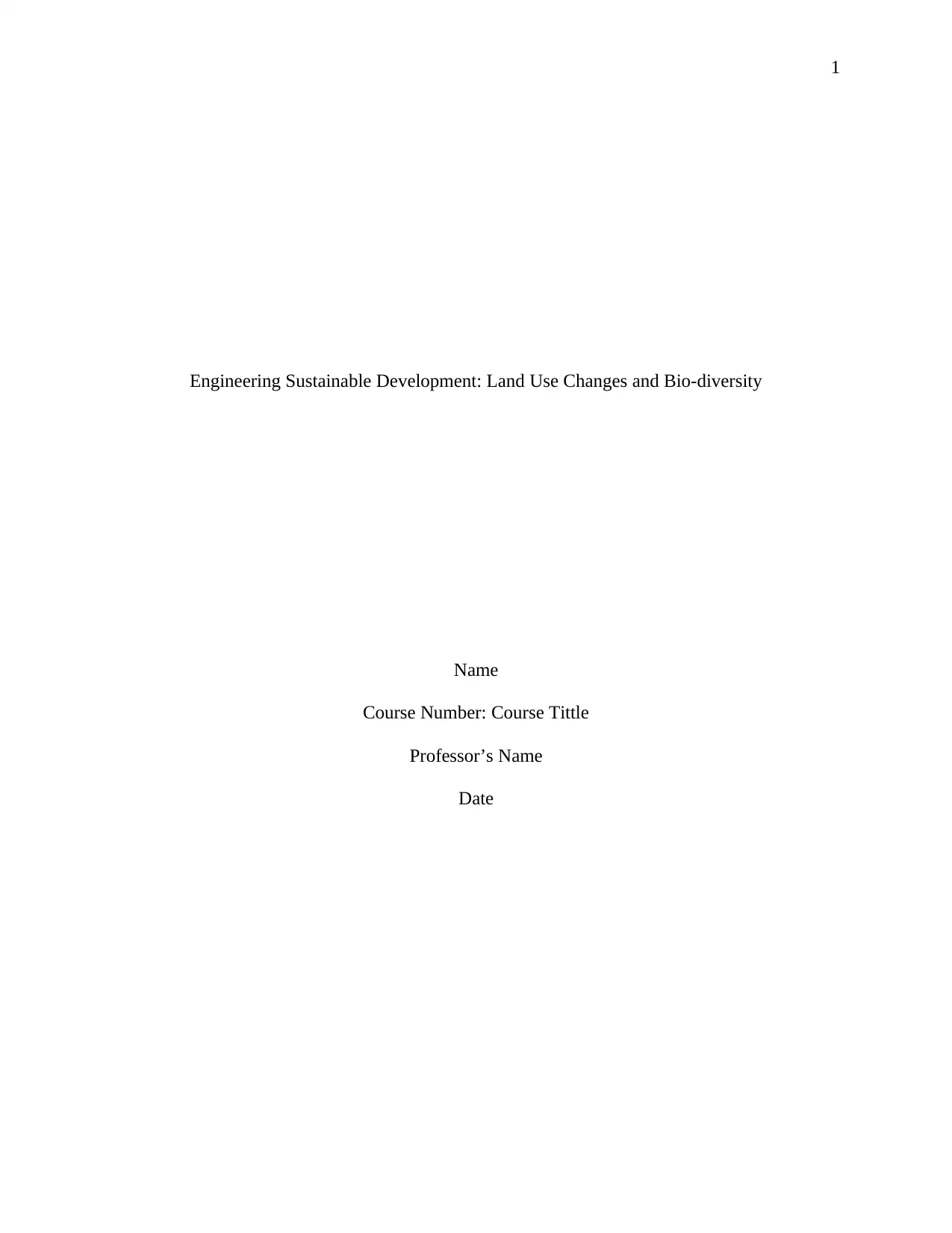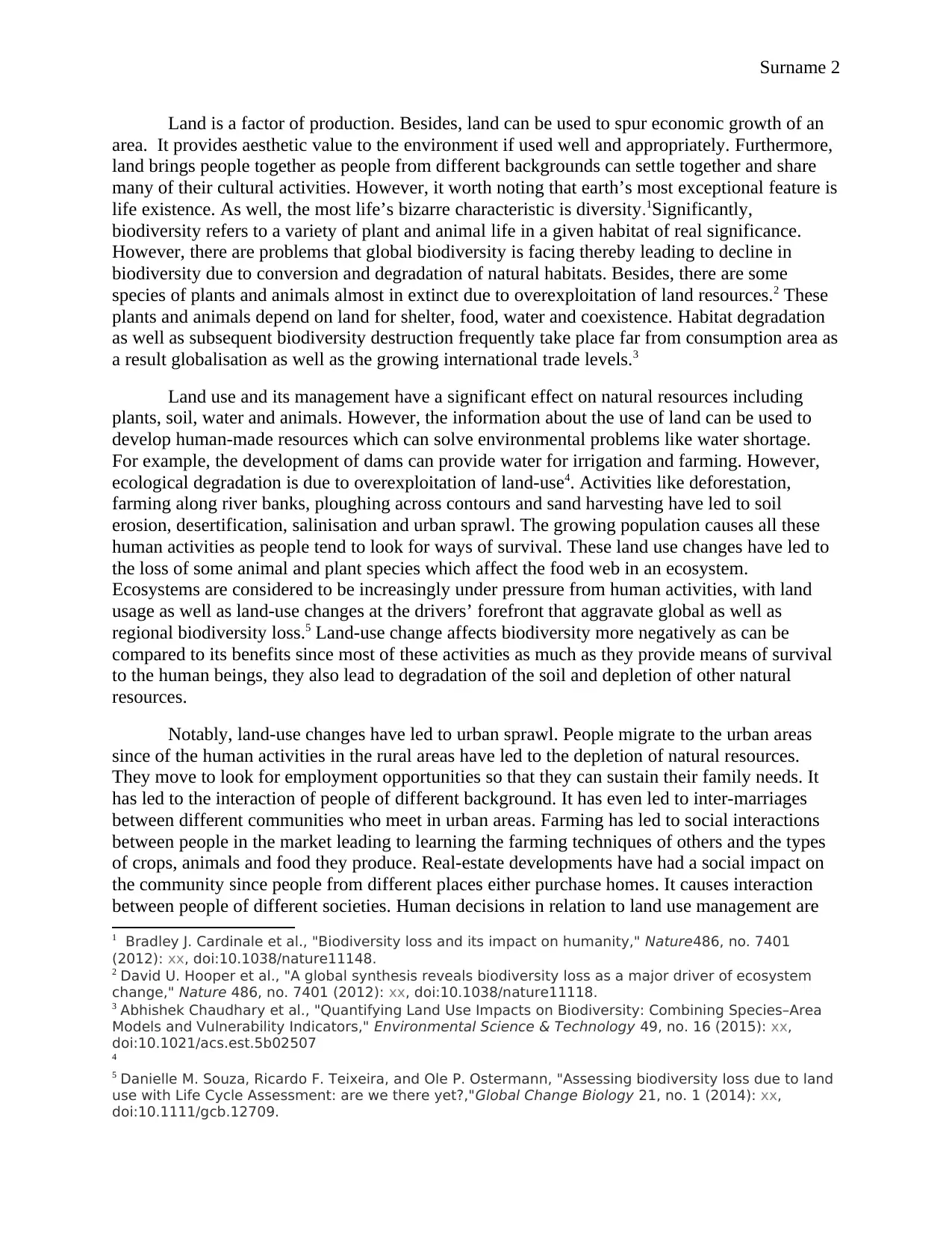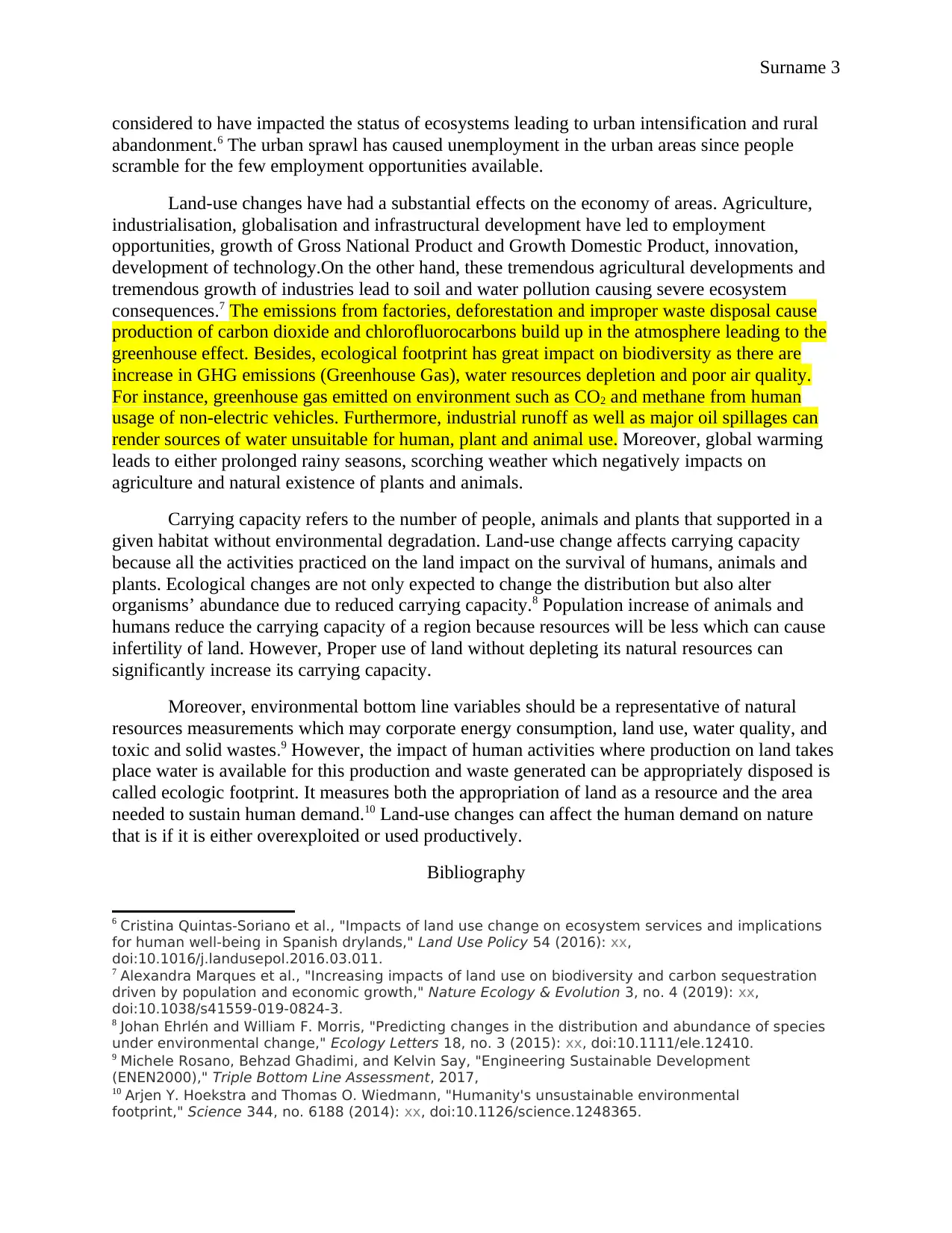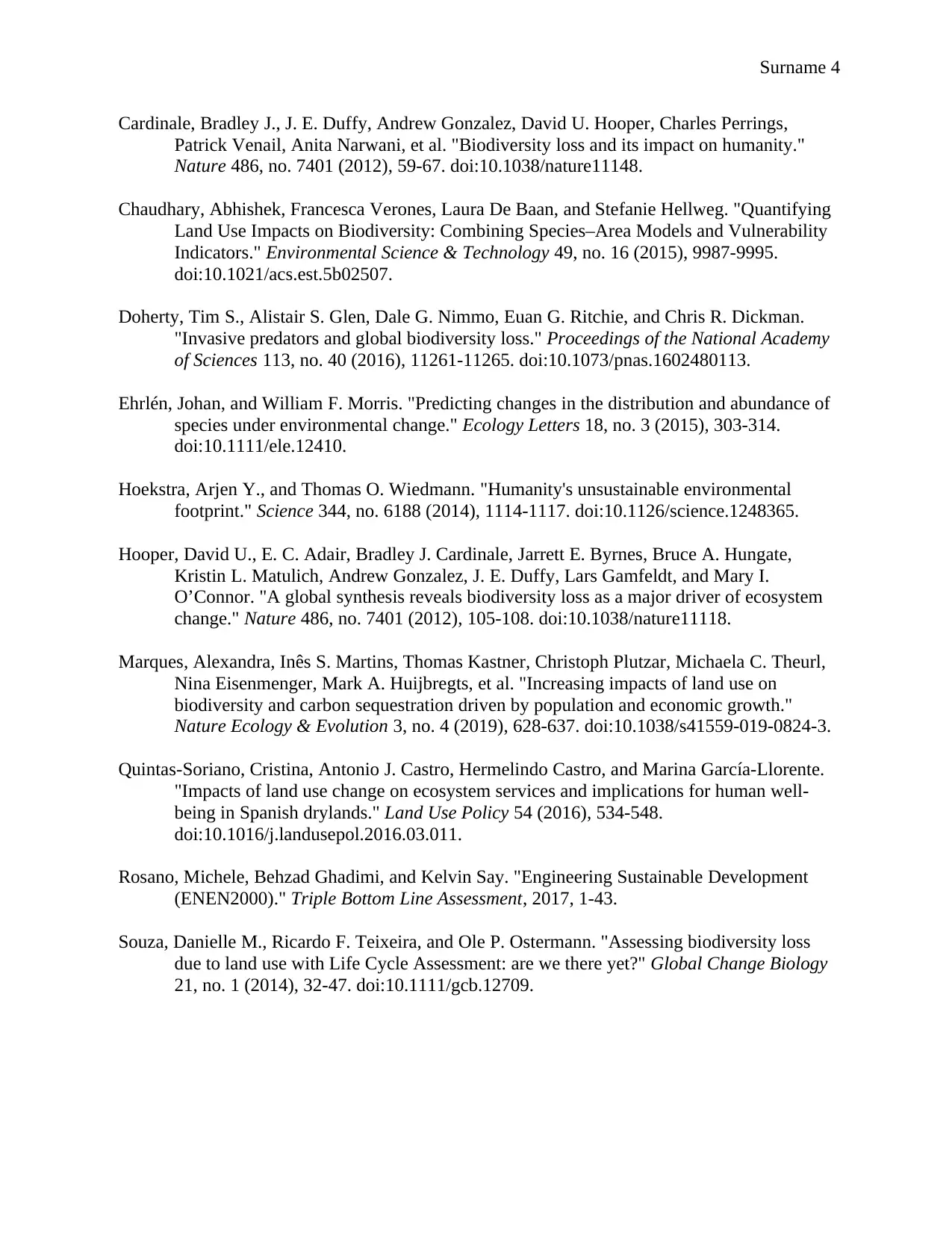ENEN2000: Land Use Changes, Biodiversity, and Sustainable Development
VerifiedAdded on 2023/01/23
|4
|1826
|22
Report
AI Summary
This report investigates the intricate relationship between land use changes and their impact on biodiversity, emphasizing the importance of sustainable development. It explores how land serves as a critical factor of production, providing aesthetic value and fostering social connections. The report highlights the detrimental effects of habitat degradation, deforestation, and urban sprawl on plant and animal species, ultimately affecting the food web and overall ecosystem health. It examines the economic and social consequences of land-use changes, including employment opportunities, technological advancements, and population shifts. The report also discusses the impact of these changes on carrying capacity, ecological footprints, and the need for environmental bottom-line variables. It concludes by emphasizing the importance of proper land management to mitigate negative impacts and promote sustainable practices, referencing key academic sources to support its findings.

1
Engineering Sustainable Development: Land Use Changes and Bio-diversity
Name
Course Number: Course Tittle
Professor’s Name
Date
Engineering Sustainable Development: Land Use Changes and Bio-diversity
Name
Course Number: Course Tittle
Professor’s Name
Date
Paraphrase This Document
Need a fresh take? Get an instant paraphrase of this document with our AI Paraphraser

Surname 2
Land is a factor of production. Besides, land can be used to spur economic growth of an
area. It provides aesthetic value to the environment if used well and appropriately. Furthermore,
land brings people together as people from different backgrounds can settle together and share
many of their cultural activities. However, it worth noting that earth’s most exceptional feature is
life existence. As well, the most life’s bizarre characteristic is diversity.1Significantly,
biodiversity refers to a variety of plant and animal life in a given habitat of real significance.
However, there are problems that global biodiversity is facing thereby leading to decline in
biodiversity due to conversion and degradation of natural habitats. Besides, there are some
species of plants and animals almost in extinct due to overexploitation of land resources.2 These
plants and animals depend on land for shelter, food, water and coexistence. Habitat degradation
as well as subsequent biodiversity destruction frequently take place far from consumption area as
a result globalisation as well as the growing international trade levels.3
Land use and its management have a significant effect on natural resources including
plants, soil, water and animals. However, the information about the use of land can be used to
develop human-made resources which can solve environmental problems like water shortage.
For example, the development of dams can provide water for irrigation and farming. However,
ecological degradation is due to overexploitation of land-use4. Activities like deforestation,
farming along river banks, ploughing across contours and sand harvesting have led to soil
erosion, desertification, salinisation and urban sprawl. The growing population causes all these
human activities as people tend to look for ways of survival. These land use changes have led to
the loss of some animal and plant species which affect the food web in an ecosystem.
Ecosystems are considered to be increasingly under pressure from human activities, with land
usage as well as land‐use changes at the drivers’ forefront that aggravate global as well as
regional biodiversity loss.5 Land-use change affects biodiversity more negatively as can be
compared to its benefits since most of these activities as much as they provide means of survival
to the human beings, they also lead to degradation of the soil and depletion of other natural
resources.
Notably, land-use changes have led to urban sprawl. People migrate to the urban areas
since of the human activities in the rural areas have led to the depletion of natural resources.
They move to look for employment opportunities so that they can sustain their family needs. It
has led to the interaction of people of different background. It has even led to inter-marriages
between different communities who meet in urban areas. Farming has led to social interactions
between people in the market leading to learning the farming techniques of others and the types
of crops, animals and food they produce. Real-estate developments have had a social impact on
the community since people from different places either purchase homes. It causes interaction
between people of different societies. Human decisions in relation to land use management are
1 Bradley J. Cardinale et al., "Biodiversity loss and its impact on humanity," Nature486, no. 7401
(2012): xx, doi:10.1038/nature11148.
2 David U. Hooper et al., "A global synthesis reveals biodiversity loss as a major driver of ecosystem
change," Nature 486, no. 7401 (2012): xx, doi:10.1038/nature11118.
3 Abhishek Chaudhary et al., "Quantifying Land Use Impacts on Biodiversity: Combining Species–Area
Models and Vulnerability Indicators," Environmental Science & Technology 49, no. 16 (2015): xx,
doi:10.1021/acs.est.5b02507
4
5 Danielle M. Souza, Ricardo F. Teixeira, and Ole P. Ostermann, "Assessing biodiversity loss due to land
use with Life Cycle Assessment: are we there yet?,"Global Change Biology 21, no. 1 (2014): xx,
doi:10.1111/gcb.12709.
Land is a factor of production. Besides, land can be used to spur economic growth of an
area. It provides aesthetic value to the environment if used well and appropriately. Furthermore,
land brings people together as people from different backgrounds can settle together and share
many of their cultural activities. However, it worth noting that earth’s most exceptional feature is
life existence. As well, the most life’s bizarre characteristic is diversity.1Significantly,
biodiversity refers to a variety of plant and animal life in a given habitat of real significance.
However, there are problems that global biodiversity is facing thereby leading to decline in
biodiversity due to conversion and degradation of natural habitats. Besides, there are some
species of plants and animals almost in extinct due to overexploitation of land resources.2 These
plants and animals depend on land for shelter, food, water and coexistence. Habitat degradation
as well as subsequent biodiversity destruction frequently take place far from consumption area as
a result globalisation as well as the growing international trade levels.3
Land use and its management have a significant effect on natural resources including
plants, soil, water and animals. However, the information about the use of land can be used to
develop human-made resources which can solve environmental problems like water shortage.
For example, the development of dams can provide water for irrigation and farming. However,
ecological degradation is due to overexploitation of land-use4. Activities like deforestation,
farming along river banks, ploughing across contours and sand harvesting have led to soil
erosion, desertification, salinisation and urban sprawl. The growing population causes all these
human activities as people tend to look for ways of survival. These land use changes have led to
the loss of some animal and plant species which affect the food web in an ecosystem.
Ecosystems are considered to be increasingly under pressure from human activities, with land
usage as well as land‐use changes at the drivers’ forefront that aggravate global as well as
regional biodiversity loss.5 Land-use change affects biodiversity more negatively as can be
compared to its benefits since most of these activities as much as they provide means of survival
to the human beings, they also lead to degradation of the soil and depletion of other natural
resources.
Notably, land-use changes have led to urban sprawl. People migrate to the urban areas
since of the human activities in the rural areas have led to the depletion of natural resources.
They move to look for employment opportunities so that they can sustain their family needs. It
has led to the interaction of people of different background. It has even led to inter-marriages
between different communities who meet in urban areas. Farming has led to social interactions
between people in the market leading to learning the farming techniques of others and the types
of crops, animals and food they produce. Real-estate developments have had a social impact on
the community since people from different places either purchase homes. It causes interaction
between people of different societies. Human decisions in relation to land use management are
1 Bradley J. Cardinale et al., "Biodiversity loss and its impact on humanity," Nature486, no. 7401
(2012): xx, doi:10.1038/nature11148.
2 David U. Hooper et al., "A global synthesis reveals biodiversity loss as a major driver of ecosystem
change," Nature 486, no. 7401 (2012): xx, doi:10.1038/nature11118.
3 Abhishek Chaudhary et al., "Quantifying Land Use Impacts on Biodiversity: Combining Species–Area
Models and Vulnerability Indicators," Environmental Science & Technology 49, no. 16 (2015): xx,
doi:10.1021/acs.est.5b02507
4
5 Danielle M. Souza, Ricardo F. Teixeira, and Ole P. Ostermann, "Assessing biodiversity loss due to land
use with Life Cycle Assessment: are we there yet?,"Global Change Biology 21, no. 1 (2014): xx,
doi:10.1111/gcb.12709.

Surname 3
considered to have impacted the status of ecosystems leading to urban intensification and rural
abandonment.6 The urban sprawl has caused unemployment in the urban areas since people
scramble for the few employment opportunities available.
Land-use changes have had a substantial effects on the economy of areas. Agriculture,
industrialisation, globalisation and infrastructural development have led to employment
opportunities, growth of Gross National Product and Growth Domestic Product, innovation,
development of technology.On the other hand, these tremendous agricultural developments and
tremendous growth of industries lead to soil and water pollution causing severe ecosystem
consequences.7 The emissions from factories, deforestation and improper waste disposal cause
production of carbon dioxide and chlorofluorocarbons build up in the atmosphere leading to the
greenhouse effect. Besides, ecological footprint has great impact on biodiversity as there are
increase in GHG emissions (Greenhouse Gas), water resources depletion and poor air quality.
For instance, greenhouse gas emitted on environment such as CO2 and methane from human
usage of non-electric vehicles. Furthermore, industrial runoff as well as major oil spillages can
render sources of water unsuitable for human, plant and animal use. Moreover, global warming
leads to either prolonged rainy seasons, scorching weather which negatively impacts on
agriculture and natural existence of plants and animals.
Carrying capacity refers to the number of people, animals and plants that supported in a
given habitat without environmental degradation. Land-use change affects carrying capacity
because all the activities practiced on the land impact on the survival of humans, animals and
plants. Ecological changes are not only expected to change the distribution but also alter
organisms’ abundance due to reduced carrying capacity.8 Population increase of animals and
humans reduce the carrying capacity of a region because resources will be less which can cause
infertility of land. However, Proper use of land without depleting its natural resources can
significantly increase its carrying capacity.
Moreover, environmental bottom line variables should be a representative of natural
resources measurements which may corporate energy consumption, land use, water quality, and
toxic and solid wastes.9 However, the impact of human activities where production on land takes
place water is available for this production and waste generated can be appropriately disposed is
called ecologic footprint. It measures both the appropriation of land as a resource and the area
needed to sustain human demand.10 Land-use changes can affect the human demand on nature
that is if it is either overexploited or used productively.
Bibliography
6 Cristina Quintas-Soriano et al., "Impacts of land use change on ecosystem services and implications
for human well-being in Spanish drylands," Land Use Policy 54 (2016): xx,
doi:10.1016/j.landusepol.2016.03.011.
7 Alexandra Marques et al., "Increasing impacts of land use on biodiversity and carbon sequestration
driven by population and economic growth," Nature Ecology & Evolution 3, no. 4 (2019): xx,
doi:10.1038/s41559-019-0824-3.
8 Johan Ehrlén and William F. Morris, "Predicting changes in the distribution and abundance of species
under environmental change," Ecology Letters 18, no. 3 (2015): xx, doi:10.1111/ele.12410.
9 Michele Rosano, Behzad Ghadimi, and Kelvin Say, "Engineering Sustainable Development
(ENEN2000)," Triple Bottom Line Assessment, 2017,
10 Arjen Y. Hoekstra and Thomas O. Wiedmann, "Humanity's unsustainable environmental
footprint," Science 344, no. 6188 (2014): xx, doi:10.1126/science.1248365.
considered to have impacted the status of ecosystems leading to urban intensification and rural
abandonment.6 The urban sprawl has caused unemployment in the urban areas since people
scramble for the few employment opportunities available.
Land-use changes have had a substantial effects on the economy of areas. Agriculture,
industrialisation, globalisation and infrastructural development have led to employment
opportunities, growth of Gross National Product and Growth Domestic Product, innovation,
development of technology.On the other hand, these tremendous agricultural developments and
tremendous growth of industries lead to soil and water pollution causing severe ecosystem
consequences.7 The emissions from factories, deforestation and improper waste disposal cause
production of carbon dioxide and chlorofluorocarbons build up in the atmosphere leading to the
greenhouse effect. Besides, ecological footprint has great impact on biodiversity as there are
increase in GHG emissions (Greenhouse Gas), water resources depletion and poor air quality.
For instance, greenhouse gas emitted on environment such as CO2 and methane from human
usage of non-electric vehicles. Furthermore, industrial runoff as well as major oil spillages can
render sources of water unsuitable for human, plant and animal use. Moreover, global warming
leads to either prolonged rainy seasons, scorching weather which negatively impacts on
agriculture and natural existence of plants and animals.
Carrying capacity refers to the number of people, animals and plants that supported in a
given habitat without environmental degradation. Land-use change affects carrying capacity
because all the activities practiced on the land impact on the survival of humans, animals and
plants. Ecological changes are not only expected to change the distribution but also alter
organisms’ abundance due to reduced carrying capacity.8 Population increase of animals and
humans reduce the carrying capacity of a region because resources will be less which can cause
infertility of land. However, Proper use of land without depleting its natural resources can
significantly increase its carrying capacity.
Moreover, environmental bottom line variables should be a representative of natural
resources measurements which may corporate energy consumption, land use, water quality, and
toxic and solid wastes.9 However, the impact of human activities where production on land takes
place water is available for this production and waste generated can be appropriately disposed is
called ecologic footprint. It measures both the appropriation of land as a resource and the area
needed to sustain human demand.10 Land-use changes can affect the human demand on nature
that is if it is either overexploited or used productively.
Bibliography
6 Cristina Quintas-Soriano et al., "Impacts of land use change on ecosystem services and implications
for human well-being in Spanish drylands," Land Use Policy 54 (2016): xx,
doi:10.1016/j.landusepol.2016.03.011.
7 Alexandra Marques et al., "Increasing impacts of land use on biodiversity and carbon sequestration
driven by population and economic growth," Nature Ecology & Evolution 3, no. 4 (2019): xx,
doi:10.1038/s41559-019-0824-3.
8 Johan Ehrlén and William F. Morris, "Predicting changes in the distribution and abundance of species
under environmental change," Ecology Letters 18, no. 3 (2015): xx, doi:10.1111/ele.12410.
9 Michele Rosano, Behzad Ghadimi, and Kelvin Say, "Engineering Sustainable Development
(ENEN2000)," Triple Bottom Line Assessment, 2017,
10 Arjen Y. Hoekstra and Thomas O. Wiedmann, "Humanity's unsustainable environmental
footprint," Science 344, no. 6188 (2014): xx, doi:10.1126/science.1248365.
⊘ This is a preview!⊘
Do you want full access?
Subscribe today to unlock all pages.

Trusted by 1+ million students worldwide

Surname 4
Cardinale, Bradley J., J. E. Duffy, Andrew Gonzalez, David U. Hooper, Charles Perrings,
Patrick Venail, Anita Narwani, et al. "Biodiversity loss and its impact on humanity."
Nature 486, no. 7401 (2012), 59-67. doi:10.1038/nature11148.
Chaudhary, Abhishek, Francesca Verones, Laura De Baan, and Stefanie Hellweg. "Quantifying
Land Use Impacts on Biodiversity: Combining Species–Area Models and Vulnerability
Indicators." Environmental Science & Technology 49, no. 16 (2015), 9987-9995.
doi:10.1021/acs.est.5b02507.
Doherty, Tim S., Alistair S. Glen, Dale G. Nimmo, Euan G. Ritchie, and Chris R. Dickman.
"Invasive predators and global biodiversity loss." Proceedings of the National Academy
of Sciences 113, no. 40 (2016), 11261-11265. doi:10.1073/pnas.1602480113.
Ehrlén, Johan, and William F. Morris. "Predicting changes in the distribution and abundance of
species under environmental change." Ecology Letters 18, no. 3 (2015), 303-314.
doi:10.1111/ele.12410.
Hoekstra, Arjen Y., and Thomas O. Wiedmann. "Humanity's unsustainable environmental
footprint." Science 344, no. 6188 (2014), 1114-1117. doi:10.1126/science.1248365.
Hooper, David U., E. C. Adair, Bradley J. Cardinale, Jarrett E. Byrnes, Bruce A. Hungate,
Kristin L. Matulich, Andrew Gonzalez, J. E. Duffy, Lars Gamfeldt, and Mary I.
O’Connor. "A global synthesis reveals biodiversity loss as a major driver of ecosystem
change." Nature 486, no. 7401 (2012), 105-108. doi:10.1038/nature11118.
Marques, Alexandra, Inês S. Martins, Thomas Kastner, Christoph Plutzar, Michaela C. Theurl,
Nina Eisenmenger, Mark A. Huijbregts, et al. "Increasing impacts of land use on
biodiversity and carbon sequestration driven by population and economic growth."
Nature Ecology & Evolution 3, no. 4 (2019), 628-637. doi:10.1038/s41559-019-0824-3.
Quintas-Soriano, Cristina, Antonio J. Castro, Hermelindo Castro, and Marina García-Llorente.
"Impacts of land use change on ecosystem services and implications for human well-
being in Spanish drylands." Land Use Policy 54 (2016), 534-548.
doi:10.1016/j.landusepol.2016.03.011.
Rosano, Michele, Behzad Ghadimi, and Kelvin Say. "Engineering Sustainable Development
(ENEN2000)." Triple Bottom Line Assessment, 2017, 1-43.
Souza, Danielle M., Ricardo F. Teixeira, and Ole P. Ostermann. "Assessing biodiversity loss
due to land use with Life Cycle Assessment: are we there yet?" Global Change Biology
21, no. 1 (2014), 32-47. doi:10.1111/gcb.12709.
Cardinale, Bradley J., J. E. Duffy, Andrew Gonzalez, David U. Hooper, Charles Perrings,
Patrick Venail, Anita Narwani, et al. "Biodiversity loss and its impact on humanity."
Nature 486, no. 7401 (2012), 59-67. doi:10.1038/nature11148.
Chaudhary, Abhishek, Francesca Verones, Laura De Baan, and Stefanie Hellweg. "Quantifying
Land Use Impacts on Biodiversity: Combining Species–Area Models and Vulnerability
Indicators." Environmental Science & Technology 49, no. 16 (2015), 9987-9995.
doi:10.1021/acs.est.5b02507.
Doherty, Tim S., Alistair S. Glen, Dale G. Nimmo, Euan G. Ritchie, and Chris R. Dickman.
"Invasive predators and global biodiversity loss." Proceedings of the National Academy
of Sciences 113, no. 40 (2016), 11261-11265. doi:10.1073/pnas.1602480113.
Ehrlén, Johan, and William F. Morris. "Predicting changes in the distribution and abundance of
species under environmental change." Ecology Letters 18, no. 3 (2015), 303-314.
doi:10.1111/ele.12410.
Hoekstra, Arjen Y., and Thomas O. Wiedmann. "Humanity's unsustainable environmental
footprint." Science 344, no. 6188 (2014), 1114-1117. doi:10.1126/science.1248365.
Hooper, David U., E. C. Adair, Bradley J. Cardinale, Jarrett E. Byrnes, Bruce A. Hungate,
Kristin L. Matulich, Andrew Gonzalez, J. E. Duffy, Lars Gamfeldt, and Mary I.
O’Connor. "A global synthesis reveals biodiversity loss as a major driver of ecosystem
change." Nature 486, no. 7401 (2012), 105-108. doi:10.1038/nature11118.
Marques, Alexandra, Inês S. Martins, Thomas Kastner, Christoph Plutzar, Michaela C. Theurl,
Nina Eisenmenger, Mark A. Huijbregts, et al. "Increasing impacts of land use on
biodiversity and carbon sequestration driven by population and economic growth."
Nature Ecology & Evolution 3, no. 4 (2019), 628-637. doi:10.1038/s41559-019-0824-3.
Quintas-Soriano, Cristina, Antonio J. Castro, Hermelindo Castro, and Marina García-Llorente.
"Impacts of land use change on ecosystem services and implications for human well-
being in Spanish drylands." Land Use Policy 54 (2016), 534-548.
doi:10.1016/j.landusepol.2016.03.011.
Rosano, Michele, Behzad Ghadimi, and Kelvin Say. "Engineering Sustainable Development
(ENEN2000)." Triple Bottom Line Assessment, 2017, 1-43.
Souza, Danielle M., Ricardo F. Teixeira, and Ole P. Ostermann. "Assessing biodiversity loss
due to land use with Life Cycle Assessment: are we there yet?" Global Change Biology
21, no. 1 (2014), 32-47. doi:10.1111/gcb.12709.
1 out of 4
Related Documents
Your All-in-One AI-Powered Toolkit for Academic Success.
+13062052269
info@desklib.com
Available 24*7 on WhatsApp / Email
![[object Object]](/_next/static/media/star-bottom.7253800d.svg)
Unlock your academic potential
Copyright © 2020–2025 A2Z Services. All Rights Reserved. Developed and managed by ZUCOL.




